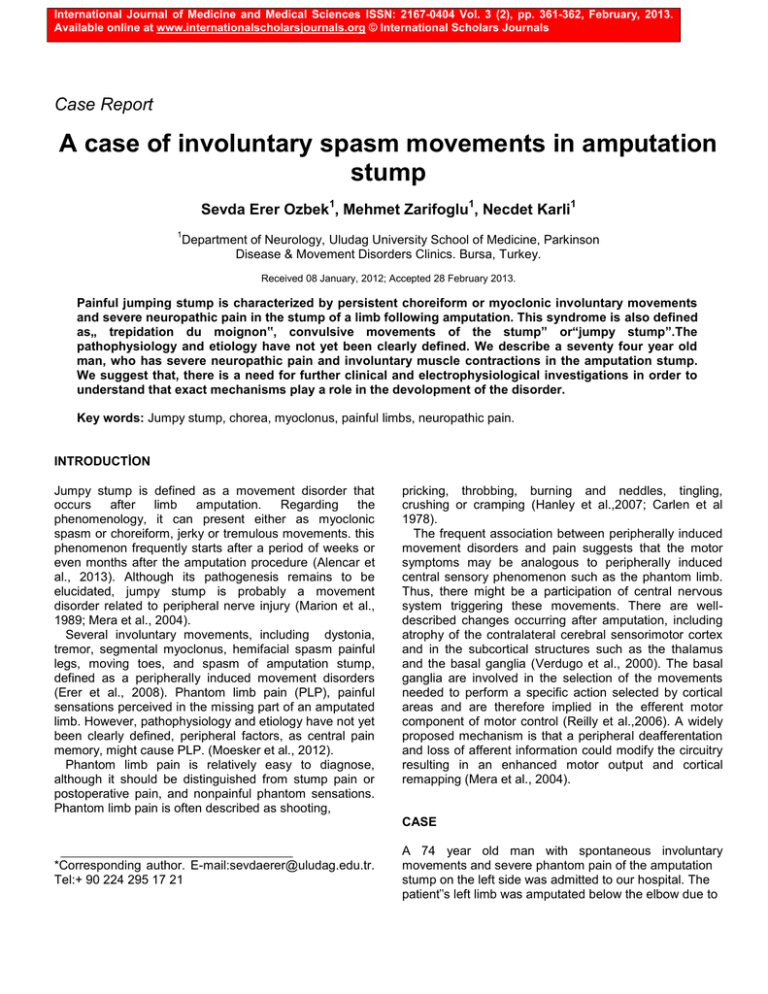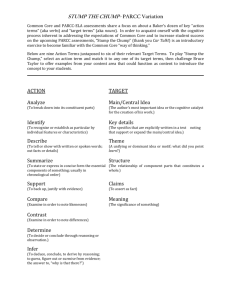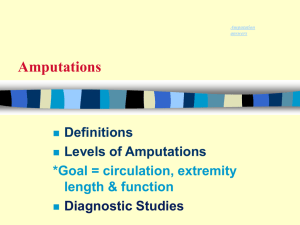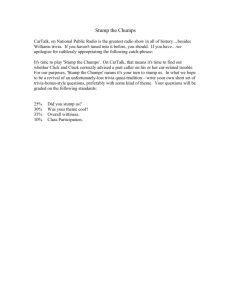A case of involuntary spasm movements in amputation stump
advertisement

International Journal of Medicine and Medical Sciences ISSN: 2167-0404 Vol. 3 (2), pp. 361-362, February, 2013. Available online at www.internationalscholarsjournals.org © International Scholars Journals Case Report A case of involuntary spasm movements in amputation stump Sevda Erer Ozbek1, Mehmet Zarifoglu1, Necdet Karli1 1 Department of Neurology, Uludag University School of Medicine, Parkinson Disease & Movement Disorders Clinics. Bursa, Turkey. Received 08 January, 2012; Accepted 28 February 2013. Painful jumping stump is characterized by persistent choreiform or myoclonic involuntary movements and severe neuropathic pain in the stump of a limb following amputation. This syndrome is also defined as„ trepidation du moignon‟, convulsive movements of the stump” or“jumpy stump”.The pathophysiology and etiology have not yet been clearly defined. We describe a seventy four year old man, who has severe neuropathic pain and involuntary muscle contractions in the amputation stump. We suggest that, there is a need for further clinical and electrophysiological investigations in order to understand that exact mechanisms play a role in the devolopment of the disorder. Key words: Jumpy stump, chorea, myoclonus, painful limbs, neuropathic pain. INTRODUCTİON Jumpy stump is defined as a movement disorder that occurs after limb amputation. Regarding the phenomenology, it can present either as myoclonic spasm or choreiform, jerky or tremulous movements. this phenomenon frequently starts after a period of weeks or even months after the amputation procedure (Alencar et al., 2013). Although its pathogenesis remains to be elucidated, jumpy stump is probably a movement disorder related to peripheral nerve injury (Marion et al., 1989; Mera et al., 2004). Several involuntary movements, including dystonia, tremor, segmental myoclonus, hemifacial spasm painful legs, moving toes, and spasm of amputation stump, defined as a peripherally induced movement disorders (Erer et al., 2008). Phantom limb pain (PLP), painful sensations perceived in the missing part of an amputated limb. However, pathophysiology and etiology have not yet been clearly defined, peripheral factors, as central pain memory, might cause PLP. (Moesker et al., 2012). Phantom limb pain is relatively easy to diagnose, although it should be distinguished from stump pain or postoperative pain, and nonpainful phantom sensations. Phantom limb pain is often described as shooting, pricking, throbbing, burning and neddles, tingling, crushing or cramping (Hanley et al.,2007; Carlen et al 1978). The frequent association between peripherally induced movement disorders and pain suggests that the motor symptoms may be analogous to peripherally induced central sensory phenomenon such as the phantom limb. Thus, there might be a participation of central nervous system triggering these movements. There are welldescribed changes occurring after amputation, including atrophy of the contralateral cerebral sensorimotor cortex and in the subcortical structures such as the thalamus and the basal ganglia (Verdugo et al., 2000). The basal ganglia are involved in the selection of the movements needed to perform a specific action selected by cortical areas and are therefore implied in the efferent motor component of motor control (Reilly et al.,2006). A widely proposed mechanism is that a peripheral deafferentation and loss of afferent information could modify the circuitry resulting in an enhanced motor output and cortical remapping (Mera et al., 2004). CASE *Corresponding author. E-mail:sevdaerer@uludag.edu.tr. Tel:+ 90 224 295 17 21 A 74 year old man with spontaneous involuntary movements and severe phantom pain of the amputation stump on the left side was admitted to our hospital. The patient‟s left limb was amputated below the elbow due to Ozbek et al. 361 a car accident in year 2005. Few weeks after the operation, intermittent mild pain started in the amputation stump. Later on, his pain became continuous and much more severe for another seven months. He also had involuntary movements as a result of continuous muscle contractions in the stump, that could be stopped by active movement. Electromyography (EMG) activity from stump muscles was performed for identification of the movement disorder that demonstrated spontaneous arrhythmic discharges of several motor unit potentials in biceps, triceps, and brachioradialis muscles during voluntary phantom limb movements. His neurological examination was normal except the movement disorder. Routine biochemical and haematological analysis were normal as well. He was initially treated with Gabapentine 300 mg/day tid, then increased to 1800 mg/day gradually, but there was no response to thearpy concerning his symptoms. Therefore, Pregabaline 300 mg/day and Paroxetine 40 mg/day were started but, these drugs were also stopped, because his complaints remained unchanged. Botulinum toxin injection and Contromal 100 mg/day were initiated, respectively. During this therapy, stump movements and pain decereased partially. After two months, Fentanyl 25 mcg/hr was added to therapy particularly for his pain. On follow-up, the amplitude of his involuntary muscle conrtractions recessed to mild amplitude, and his phantom pain decreased to an acceptable level. CONCLUSİON Involuntary movements in the stump after amputation are usually defined as myocloni or chorea. However, different type of movements such as tremor or spasm are reported very rarely in the literature (Kulisevsky et al., 1992). These movements are generally associated with severe pain in the stump (Mera et al.,2004; Erer et al., 2008; Moesker et al.,2012; Hanley et al.,2007). The jumpy stump movements are the more frequent cause of organic etiology, nevertheless Zadikoff C et al. presented a case of psychogenic jumpy stump , in which paroxysmal rhythmical jerking movements of the stump were associated with palpable muscle activation in the proximal limb also several features consistent with a psychogenic origin, including variability, distractibility and other comorbid psychiatric features (Zadikoff et al.,2006). Kulisevsky J et al reported two cases those experienced involuntary movements in the stump accompanied with muscle spasm. In the first case, these movements began acutely 3 days after the amputation, but in the second patient symptoms started 2 months after the amputation following a latent period, therefore, in a chronic fashion(Kulisevsky et al., 1992). Additionally, Mera J et.al also reported a case with spontaneous, involuntary, autonomous movements in the stump that occured subacutely, that means 2 weeks after the amputation(Mera et al.,2004). Our patient‟s movement disorder observed in the late choronic period that is in contradiction with the previous reports. Although involuntary movements may develop in acute postoperative period, sometimes symptoms maybegin in subacute or choronic stages after the amputation. Underlying pathophysiology and mechanisms of this disorder are still unknown. Cortical, peripheral and also spinal mechanisms may play a role. (Mera et al.,2004; Reilly et al.,2006). However, central cortical and subcortical reorganization in response to altered peripheral input, coupled with individual predisposition, was proposed (Erer et al., 2008; Elsner et al., 2012). Reilly KT et al was found that distinct movements of the phantom limb were associated with distinct patterns of EMG activity in the remaining stump muscles, and therefore that the cortical motor network controlling the limb was differentially activated during the production of different phantom movements(Reilly et al., 2008). They proposed that preserved phantom limb movement representations re-target the stump muscles to express themselves associated with primary motor cortex reorganization after amputation (Reilly et al., 2006). Neuropathic pain is commonly seen in jumping amputation stumps. Peripheral nerve injury may lead to pain. Moreover, damaged peripheral nerves can disturb afferent inputs to spinal cord andcortex, and this might trigger persistant involuntary movements consisting of myocloni, chorea, tremulousness or spasms (Reilly et al., 2006; Lang et al.,1997; Jankovic et al., 1988; Chalaupka et al.,1999). The symptoms in our case support this hypothesis, depending on the relationship between his severe pain and movement disorder. It has also been suggested that, amputation of a limb causes cortical somatosensory modifications, and those modified sensorimotor activities affect the areas close to the represented cortical area of the missing limb. As a result, modified sensorimotor activities can induce involuntary movement and sensation of pain in the stump (Reilly et al., 2006). Altough the treatment of jumpy stump is challenging and usually unsuccessful, there have been a few cases responsive to therapy, in the literature (Alencar et al.,2013; Mera et al.,2004; Zadikoff et al., 2006). Therefore, therapy approachs are important. In conclusion, we think that, stump movements in our case are different from those previously reported as myoclonic or choreic movements. We suggest that, there is a need for further clinical and electrophysiological investigations in order to understand exact mechanisms play in the devolopment of the disorder, to make a correct diagnosis and to modify treatment modalities. 362 Int. J. Med. Med. Sci. REFERENCES Alencar R, Camargos S, Cardoso T, Maia D, Cardoso F (2013). Jumpy stump triggered by tardive dyskinesia NeurolSci.34(1):125-6. doi: 10.1007/s10072-012-0954-8. Carlen PL, Wall PD, Nadvorna H, Steinbach T (1978) Phantom limbs and related phenomena in recent traumatic amputations.Neurology; 28:211–217. cases. Mov Disord; 4:354-358. Chalaupka FD, Bernardi M (1999). A case of segmental myoclonus in amputation stump: evidence for spinal generator and physiopathogenetic hypothesis. Ital. J. Neurol. Sci. 20:327-331. Elsner C, D'Ausilio A, Gredebäck G, Falck-Ytter T, Fadiga L (2012). The motor cortex is causally related to predictive eye movements during action observation. Neuropsychologia. 51(3):488-492. doi: 10.1016. Erer S, Jankovic J (2008). Adult onset tics after peripheral injury. Parkinsonism Relat Disord;14(1):75-6. Hanley MA, Jensen MP, Smith DG, Ehde DM, Edwards WT, Robinson LR (2007). Preamputation pain and acute pain predict chronic pain after lower extremity amputation. J. Pain; 8:102–109. Jankovic J, Van Der Linden C (1988). Dystonia and tremor induced by peripheral trauma: predisposingfactors. J. Neurol. Neurosurg Psychiatr. 1512-1519. Kulisevsky J, Marti-Fabregas J, Grau JM (1992). Spasms of amputation stumps. J. Neurol. Neurosurg. Psychiatr. 1992;55:626-627. Lang CJG, Sittl H, Erbguth F (1997). Autonomous stump movements in brain death. Eur Neurol. 37:249. Marion MH, Gledhill RF, Thompson PD (1989). Spasms of amputation stumps: a report of 2 Mera J, Martinez-Castrillo JC, Mariscal A, Herrero A, Alvarez-Cermeño JC (2004). Autonomous stump movements responsive to gabapentin. J Neurol;251:346–347. Moesker AA, Karl HW, Trescot AM (2012). Treatment of Phantom Limb Pain by Cryoneurolysis of the Amputated Nerve. Pain Pract. doi: 10.1111/papr.12020: 1-5 Reilly KT, Mercier C, Schieber MH, Sirigu A (2006). Persistent hand motor commands in the amputees' brain. Brain.129(8):2211-23. Reilly KT, Mercier C, Schieber3 MS, Sirigu A (2006). Persistent hand motor commands in the amputees‟ brain. Brain;129: 2211–2223. Reilly KT, Sirigu A (2008). The motor cortex and its role in phantom limb phenomena. Neuroscientist. 14(2):195-202. Verdugo RJ, Ochoa JL (2000) Abnormal movements in complex regional pain syndrome: assessment of their nature. Muscle Nerve; 23:198–205. Zadikoff C, A Mailis-Gagnon, A E Lang (2006). A case of a psychogenic "jumpy stump"J. Neurol. Neurosurg. Psychiatr; 77;1101.




